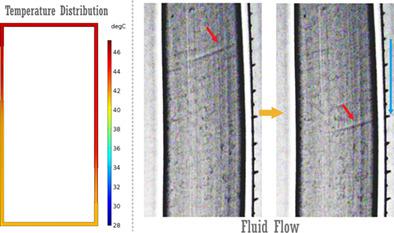当前位置:
X-MOL 学术
›
Int. J. Energy Res.
›
论文详情
Our official English website, www.x-mol.net, welcomes your
feedback! (Note: you will need to create a separate account there.)
Experimental and simulation approach of the loop geometry effect on the natural circulation system of the advanced nuclear reactor
International Journal of Energy Research ( IF 4.3 ) Pub Date : 2020-09-14 , DOI: 10.1002/er.5903 Duwi Hariyanto 1 , Sidik Permana 1, 2 , Suprijadi 3
International Journal of Energy Research ( IF 4.3 ) Pub Date : 2020-09-14 , DOI: 10.1002/er.5903 Duwi Hariyanto 1 , Sidik Permana 1, 2 , Suprijadi 3
Affiliation

|
Lately, natural circulation has become an exciting topic because it has been proposed and applied in some advanced nuclear reactors as a passive safety system. The aim of the present study is to examine the effect of the loop geometry on the natural circulation based cooling system of a given power source. The experimental approach was achieved by the construction of two natural circulation loops with vertical heater and vertical cooler. Both circulation loops were built with a same vertical length of 100 cm and different horizontal lengths, each of 50 and 100 cm, respectively. The heater was realized with a stainless pipe wrapped by a Nichrome wire, whereas the cooling system was designed and built as a pipe in 30 cm long square tube. Thus, the cooling water will circulate around the pipe loop inside the rectangular cooling chamber. The temperature data acquisition was achieved via an Arduino-based system, controlling four K-type thermocouple sensors. The numerical simulation part in the present work, was carried out by the COMSOL Multiphysics software, using the dedicated heat transfer and fluid dynamic module, namely the computational fluid dynamic module. The experimental data were considered to parameterize the COMSOL input model. The experimental results showed a clear difference between two passive cooling loops according to the horizontal length. The doublings of the horizontal and vertical lengths of the loop have a direct effect on the fluid flow rate.
中文翻译:

先进核反应堆自然循环系统回路几何效应的实验与仿真方法
近来,自然循环已成为一个令人兴奋的话题,因为它已被提出并应用于一些先进的核反应堆作为被动安全系统。本研究的目的是检查回路几何形状对给定电源的基于自然循环的冷却系统的影响。实验方法是通过构建两个带有立式加热器和立式冷却器的自然循环回路来实现的。两个循环回路均采用相同的垂直长度 100 厘米和不同的水平长度,分别为 50 和 100 厘米。加热器是用一根由镍铬合金线包裹的不锈钢管实现的,而冷却系统则是设计和建造在 30 厘米长的方管中的管子。因此,冷却水将在矩形冷却室内的管道回路周围循环。温度数据采集是通过基于 Arduino 的系统实现的,控制四个 K 型热电偶传感器。目前工作中的数值模拟部分是通过 COMSOL Multiphysics 软件进行的,使用专用的传热和流体动力学模块,即计算流体动力学模块。实验数据被视为参数化 COMSOL 输入模型。实验结果表明,根据水平长度,两个被动冷却回路之间存在明显差异。回路水平和垂直长度的加倍对流体流速有直接影响。使用专用的传热和流体动力学模块,即计算流体动力学模块。实验数据被视为参数化 COMSOL 输入模型。实验结果表明,根据水平长度,两个被动冷却回路之间存在明显差异。回路水平和垂直长度的加倍对流体流速有直接影响。使用专用的传热和流体动力学模块,即计算流体动力学模块。实验数据被视为参数化 COMSOL 输入模型。实验结果表明,根据水平长度,两个被动冷却回路之间存在明显差异。回路水平和垂直长度的加倍对流体流速有直接影响。
更新日期:2020-09-14
中文翻译:

先进核反应堆自然循环系统回路几何效应的实验与仿真方法
近来,自然循环已成为一个令人兴奋的话题,因为它已被提出并应用于一些先进的核反应堆作为被动安全系统。本研究的目的是检查回路几何形状对给定电源的基于自然循环的冷却系统的影响。实验方法是通过构建两个带有立式加热器和立式冷却器的自然循环回路来实现的。两个循环回路均采用相同的垂直长度 100 厘米和不同的水平长度,分别为 50 和 100 厘米。加热器是用一根由镍铬合金线包裹的不锈钢管实现的,而冷却系统则是设计和建造在 30 厘米长的方管中的管子。因此,冷却水将在矩形冷却室内的管道回路周围循环。温度数据采集是通过基于 Arduino 的系统实现的,控制四个 K 型热电偶传感器。目前工作中的数值模拟部分是通过 COMSOL Multiphysics 软件进行的,使用专用的传热和流体动力学模块,即计算流体动力学模块。实验数据被视为参数化 COMSOL 输入模型。实验结果表明,根据水平长度,两个被动冷却回路之间存在明显差异。回路水平和垂直长度的加倍对流体流速有直接影响。使用专用的传热和流体动力学模块,即计算流体动力学模块。实验数据被视为参数化 COMSOL 输入模型。实验结果表明,根据水平长度,两个被动冷却回路之间存在明显差异。回路水平和垂直长度的加倍对流体流速有直接影响。使用专用的传热和流体动力学模块,即计算流体动力学模块。实验数据被视为参数化 COMSOL 输入模型。实验结果表明,根据水平长度,两个被动冷却回路之间存在明显差异。回路水平和垂直长度的加倍对流体流速有直接影响。











































 京公网安备 11010802027423号
京公网安备 11010802027423号